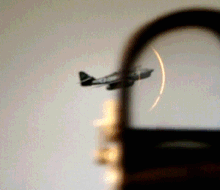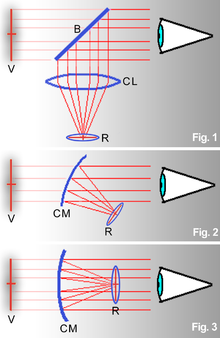Reflex sight
A reflex sight or collimator sight is an optical sight for firearms and smaller astronomical telescopes . The modern design is a red dot sight , red dot sight , dot sight or by the manufacturer as a Red Dot or Aimpoint referred.
The first modern red dot sights for handguns come from the Swedish company Aimpoint .
In contrast to the riflescope , a reflex sight offers little or no magnification, but is free of parallax . In contrast to the riflescope, the target is captured with both eyes . Due to the design, a target can be aimed in the shoulder stop of long guns both precisely and very quickly over short and (shorter) medium distances (100 m to 150 m as with the G36 ) . Hits up to lower long distances are possible depending on the extended trajectory of the bullet.
In contrast to a target point projector, the reflex sight does not emit an active beam of light which, in conjunction with the weapon, is used for searching, aiming and quick acquisition in the twilight and at night, for accurate shooting from the hip stop by illuminating the target . Reflex sights are also suitable for combat in built-up areas ( CQB , " Close Quarters Battle ").
Early systems were found in the gun sights of WWII fighters and in the ring sights of anti-aircraft weapons , which were constructed using the effect of Newton's rings .
principle
A luminous target point (or another reticle ) is reflected into the shooter's eye via a semi-transparent mirror. A lens optic ( collimator ) ensures that this reticle appears to the shooter at infinity (or, if the target is closer, it appears closer). The archer sees the target and the reticle reflected by the mirror at the same time through the semi-transparent mirror. Since the light beam of the reticle falls into the eye exactly from the direction of the line of sight, the reticle always appears in the right place regardless of the position of the eye relative to the sighting device.
There are basically three types:
- The reticle and the collimator lens are at right angles to the beam path of the target being viewed. The two images are mixed using a beam splitter or a glass plate. This type takes up a lot of space and is mainly used in aircraft head-up displays .
- A more compact type uses a curved dichroic mirror , which both focuses the reticle and mixes the two images. This type is often used as a red dot sight on handguns.
- In Lieuwe Van Albada's type , the reticle lies between the viewer and the curved mirror. The reticle itself is too close to be in the focus of the viewer, but the curved mirror mixes the two images in infinity. This type was used as a viewfinder for cameras, but also as a weapon sight, for example in the bazooka .
Advantages over other visors

- The target is sighted with both eyes - spatial vision and the full field of vision are retained.
- The common aiming errors of fine grain , whole grain or clamped front sight when aiming over the rear sight and front sight do not exist with the reflex sight.
- Since the target point is mapped to infinity using optics, the eyes can focus on the target point and target at the same time. This is not possible with the rear sight and front sight, which are much closer to the shooter, so that either the sighting device or the target can always be seen slightly out of focus.
- The luminous target point makes sighting possible even in the dark, as long as the target itself is still visible. In order not to be dazzled by the light point itself, its brightness can usually be adjusted.
- In contrast to any type of target lighting (such as a laser or a lamp mounted on the weapon), a reflex sight in Germany is also permitted for hunting and sport shooting under gun law.
- The target is not alerted that it is being sighted as is the case with target lighting methods.
disadvantage
- Target optics such as reflex sights can fog up if there is a sudden sharp drop in temperature or accidentally breathing on at low temperatures; an exception are newer ones with a lotus effect coating.
- Sunlight can reflect off the lens of the reflex sight and be noticed by game or an opponent; However, this also applies to any other form of optical aiming aids. Honeycomb-like inserts sold as "killflash" prevent reflection.
- Most reflex sights require an additional energy source for the illuminated dot. Individual models work with the help of light guides in daylight without an additional energy source or use the tritium light sources that are banned in some countries and that function for more than ten years.
- Reflex sights are very bulky on handguns . The weapons cannot be carried in the usual holsters with these visors; In the case of handguns, laser projectors are therefore superior because of their German language skills.
Assembly
Due to their low weight, they can be mounted on almost all handguns. Reflex sights for firearms are usually mounted on Picatinny , Weaver , 11 mm prism rails or Suhl hook mounts , which in turn are attached to the gun barrel. An assembly instead of a rifle scope is usually possible, in connection with an interchangeable assembly also alternating with a rifle scope. Mounting with a laser light module or just a white light at the same height is possible, but only allowed for official weapons in Germany. The installation of an LLM at the front leads to a change in the holding point. In the case of pistols, they are also attached to bridge mounts, which then no longer allow sighting over the rear sight and front sight.
Offshoot
- The largely twist-free and parallax-free reflex sights can also be found in measuring devices and cameras (in the bright line viewfinder ).
- Aiming devices such as the Telrad finder are used on amateur astronomical telescopes .
See also
Web links
Individual evidence
- ↑ Heckler & Koch HK Aim Point Projector brochure mp5 gun, HK target telescopes for handguns, page 37, February 21, 2006.
- ^ Francis B. Patrick: Military Optical Instruments in: Title Optical Instruments, Part 2 , Verlag Elsevier, 2012, ISBN 978-0-323-15223-5 , p. 198 [1]
- ↑ David Link: How Do Reflex Sights And Holographic Sights Differ? , April 3, 2015 [2]
- ^ Norman Goldberg: Camera Technology: The Dark Side of the Lens , Verlag Academic Press, 1992, ISBN 978-0-08-050066-9 , p. 302 [3]
- ^ Howard Grubb: A New Collimating-telescope Gun-Sight For Large And Small Ordnance. In: The Scientific transactions of the Royal Dublin Society . Vol. VII, August 1901. pp. 321-330.


